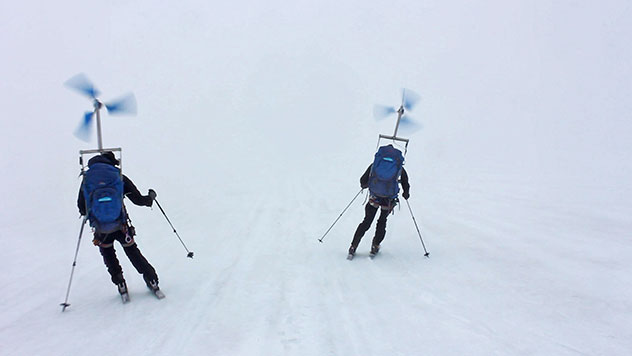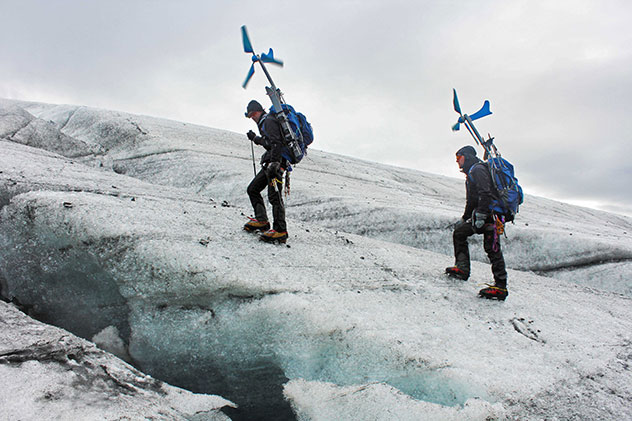GÆG – Thomas Huber & Wolfgang Aichner
Curator – Dr. Christian Schoen
Concept for a 1-week art performance
at Vatnajökull, Iceland in September 2013
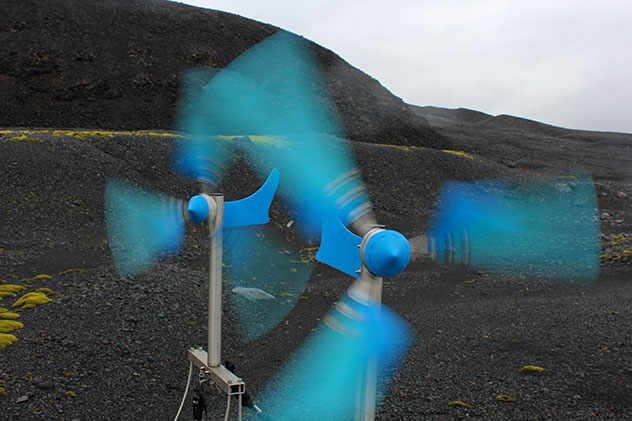
For powerwalk the two artists from Munich, Thomas Huber & Wolfgang Aichner, walked in the course of a one week expedition on Europe’s largest glacier, the Icelandic Vatnajökull as human power stations.
During their undertaking in September 2013 they carried mobile wind generators, producing permanently electricity. That way generated and in special batteries accumulated wind energy indicates the artistic gain of the undertaking. The exploitation of energy and its consumption, staged in this project in two separate paces, evolves a strongly metaphorical quality.
In powerwalk the artists create an absurd image, which broaches the issue of the current race for resources and energies between the industrial countries and a society orientated towards efficiency, profit and entertainment. The performance, documented cinematically and photographically, will be formatted installation based for exhibitions.
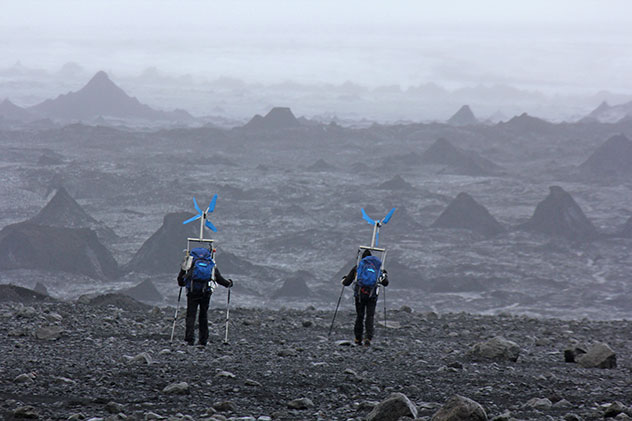
Charging
The actual power station consists of two wind generators, which are conceived as portable units for the backpacks. Additionally to further equipment like tent, sleeping bags and food, the artists carried accumulators, which have kept the collected wind energy of the timespan of the one week performance.
A film-crew located at the basecamp has documented the breakup of the protagonists, while the actual peregrination has been recorded by a cameraman, the artists themselves and partly by action-cams. The daily progress, as well in terms of covered distance and climbed altitude meters, as in average calorie consumption and the accumulated electricity, has been documented thoroughly and supplemented by objective status reports and predictions about weather, wind speed etc.
All data was merged on basis of ordinance survey and was evaluated (pseudo)scientifically.
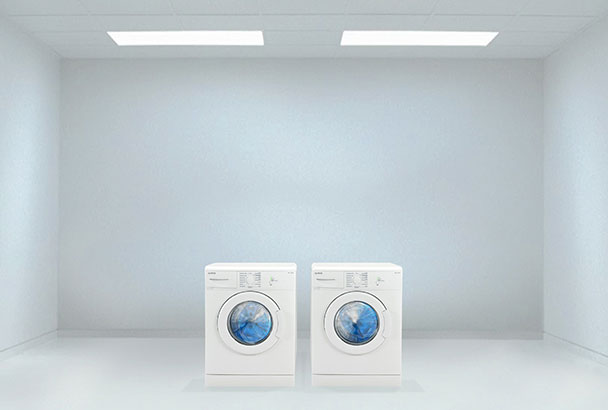
Discharging
The energy generated on the glacier and accumulated in batteries, is transported back to Germany. Here it is used to operate two washing machines, laundering the expedition-clothes of the artists. As long as the accumulated electricity lasts, the washing process is filmed in real-time mode.
Likewise the period of this film determinates the one of the second film, which shows the actual expedition. Both films eventually are – beside the artifacts (wind generators and garment), the digital on-/offline documentation and, if applicable, photographs – the central elements of exhibition. Both films of identic length are opposed to each other in context of an exhibition, viz. the one film starts with the breakup from the basecamp at the foot of the glacier, the other with the loading of the washing machines.
Additionally to the cinematic installation in context of the exhibition, a separate film will be edited to be submitted in film-festivals and to be distributed on DVD later. Furthermore in extracts electricity has been generated to accumulate ten smaller batteries, which subsequently in combination with a photograph is provided as the edition “GÆGpower”.
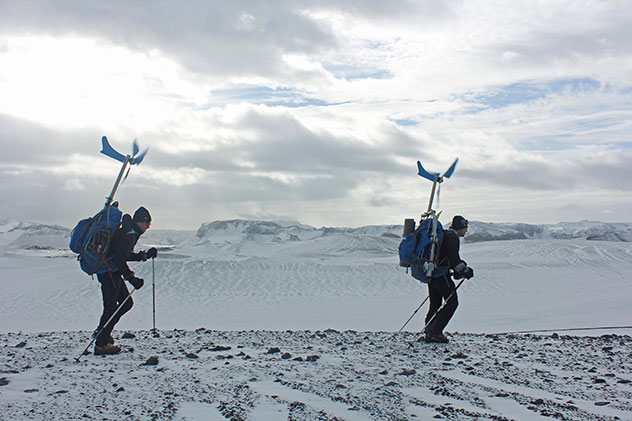
The Range
In October 1988 the artists Thomas Huber and Wolfgang Aichner attempted to cross the Icelandic glacier Vatnajökull by foot. On the edge of the crater of the volcano Grimsvötn the undertaking became imminent in a blizzard lasting for 2½ weeks and almost ended in disaster.
Like then the artists have done their powerwalk by alpinist means: by foot. Therefore also a sequence of their own history was meant to be rehabilitated. In the project, the leftover route, not having been accomplished by the artists 25 years earlier, was supposed to be covered– between the edge of the glacier near Jökulheimar and the refuge at the crater of the subglacial central volcano Grimsvötn. But an early onset of winter with severe storms forced the artist consistently to withdrawals. Eventually the camp in the highlands was given up and the Sultartungnajökull in the south east of Vatnajökull, at the Skálafells glacier tongue was chosen for an access. Starting from here, the terrain edge to the glacier plateau was reached.
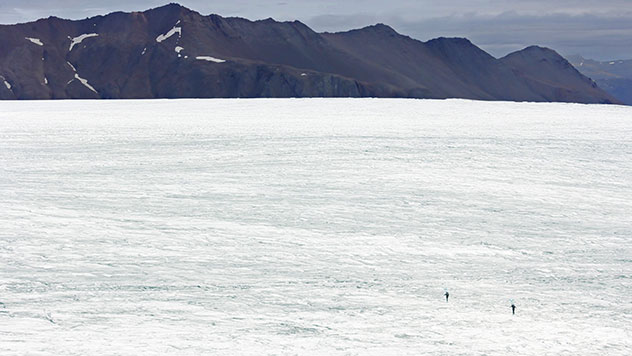
GÆG - global aesthetic genetics
The unintended initiation rite in the Icelandic blizzard supplied the Æ in the artists’ label GÆG, since among other things it is an Icelandic character. This shared liminal experience in 1988 welded the Munich artists together as friends, later also as artists. In 2005 Huber and Aichner appeared for the first time publicly as an artists’ partnership on the occasion of the project tilia inflata®, which criticized “genetic technology and patent politics”. With their contribution for the Bienniale passage2011, they succeeded in their first sensational undertaking.
www.gaeg.net
Thomas Huber
studied painting at the Academy of Fine Arts Munich under Horst Sauerbruch. 1993 he started a series of actionist land art projects, primarily in the Arctic regions. In addition to painting, he also works with object art, installations and media.
www.thomashuber.org
Wolfgang Aichner
graduated in Fine Arts at the University of East London after studying architecture in Munich. Within the framework of a scholarship from the New York-based Pollock- Krasner Foundation he worked for a year in Dublin. Between 1997 and 2008 he lectured at three universities.
www.wolfgang-aichner.de
